How to Raise a 165-Year-Old Cat
Bacon, champagne, and 3D movies? Why one Texas man thinks he’s uncovered an unlikely formula for feline longevity.

Jake Perry. (All Photos: Phil Kline)
Jake Perry is a cat man. Standing about 5-foot-7 and often clad in workman’s clothes, the 85-year-old Austin, Texas, plumber is also a father and husband. But anyone who’s met Perry will tell you—first and foremost, he’s a cat man.

Perry’s cats broke the Guinness World Record for oldest cat. Twice, actually: The first record, from 1998, was for a part Sphynx, part Devon Rex named Granpa Rexs Allen who made it to age 34; the second, from 2005, is for a mixed tabby named Creme Puff who lived to age 38. Since the 1980s, Perry has adopted and re-homed hundreds of cats, at his peak raising four dozen at once, showcasing the best and brightest in cat shows. According to Perry, it’s not just Granpa and Creme Puff who had unusually long lives: About a third of his cats, he says, lived to be at least 30 years old—about twice the average feline life span.
Over the years, Perry has been equally celebrated and psychologically analyzed for his extreme dedication to his pets. Now, toward the end of his own life, he believes he’s discovered the secret to feline longevity.
I first met Perry on a hot summer day in July 2012, when he showed up at my apartment to fix a leaky bathtub. He was strangely magnetic, with a slow Texas drawl, compulsive politeness, and a face that lit up when he saw the apartment’s resident pet—this was not your typical plumber. That day, Perry told me about his own cats, and what he believed were the keys to their unbelievably long lives.
First, there was their daily diet: on top of dry commercial cat food, a home-cooked breakfast of eggs, turkey bacon, broccoli, coffee with cream, and—every two days—about an eyedropper full of red wine to “circulate the arteries.” Then there was his effort to ensure the cats were sufficiently stimulated: a garage he’d converted into a home movie theater, with a working reel-to-reel projector and actual movie theater seats, where Perry screens nature documentaries exclusively for the cats (with previews, he added). Last, and perhaps most important, he swore that love and close, personal relationships helped his cats live longer. Perry adored his cats so much, he remembered each of their birthdays. (Bill Clinton was invited to Granpa’s 34th; the president sent a card with his regrets.)
I had a hard time believing him. A plumber who searches for the feline fountain of youth when he’s not unclogging the drains of Austin sounded more like a third-tier superhero than a real person. But the more I thought about it, I couldn’t imagine why someone would lie about having an absurd number of cats or a uniquely close relationship with them. As the days passed, my questions about Perry mounted. If he’s adopted hundreds of pets over the years, how does that affect his neighbors? Who’s the veterinarian who treats Perry’s ancient cats?
I found myself googling when I should have been sleeping. News articles about Perry’s two world records were easy to find, but it wasn’t until I stumbled upon a student documentary with footage of the cat movie theater that the details of his story seemed plausible. I called for an interview. He agreed—on five separate occasions—but then didn’t return my calls for months. The man who may have accidentally discovered feline semi-immortality had vanished.
Which is the short version of how I found myself in Texas, crawling through a thicket of bamboo in a neighbor’s yard, craning my neck to get a glimpse of the cat graveyard next door and trying to unlock the secret for myself.
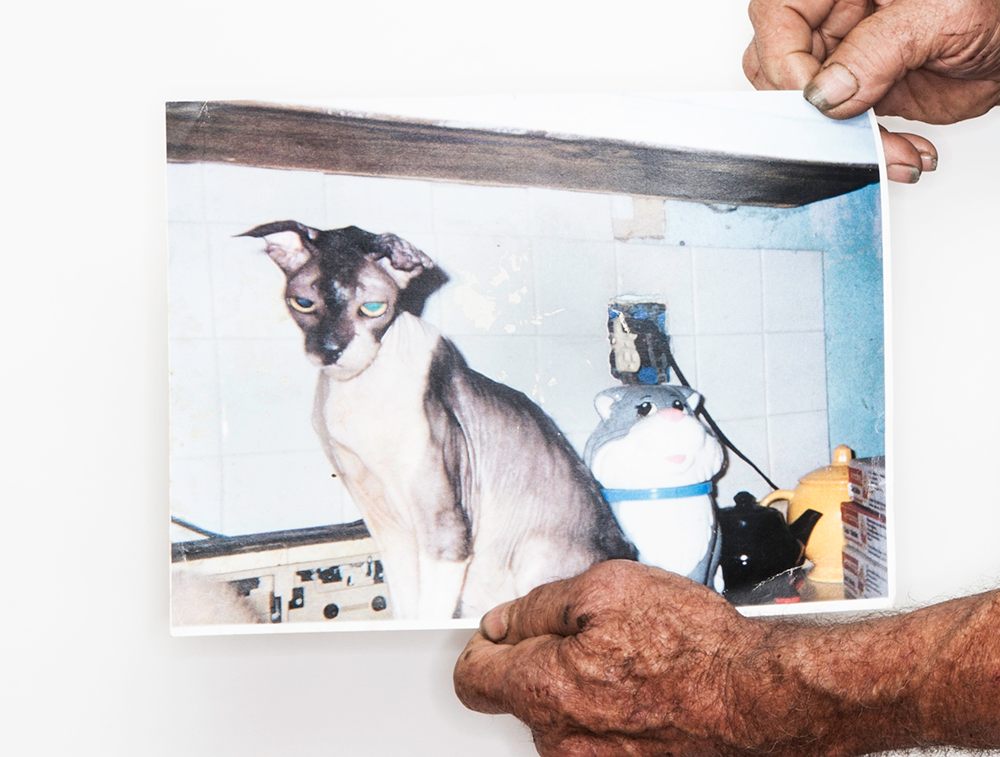
Jake holding a photograph of Granpa, who lived to the age of 34.
“It’s not what they taught us in school, you know?” The owner of South Congress Veterinary Clinic, Bruce Hardesty, shrugs when asked about the Perry cats’ diets. The longest-living of them celebrate their birthdays in Hardesty’s clinic with a barrage of media attention, and special tuna and broccoli birthday cakes. Framed photos of those who made it to age 34 hang on Hardesty’s office wall, along with official Guinness World Record certificates.
Now in his late 50s, Hardesty has been Perry’s vet for the last 15 years—he’s seen 40 to 50 of Perry’s cats. Hardesty believes at least six of them reached age 30, with several more making it to 25. For many, however, it’s impossible to know their precise ages. “It’s not like you can cut them open and count the rings,” he says.
All he’ll concede—or speculate—is that there could be something to the cats’ coffee. “The kidneys are one of the weaker systems in the cat,” he says. “If you gave them a little bit of diuretic, which caffeine [is], maybe that would help?”
Which is to say: The science behind Perry’s longevity formula is shaky at best. The American Society for the Prevention of Cruelty to Animals regards caffeine as toxic to cats. Jennifer Larsen, an associate professor of clinical nutrition at the University of California, Davis School of Veterinary Medicine, agrees. “Caffeine and alcohol are not advisable and can be harmful,” she writes over email. She also says that her school recommends cats not consume more than 10 percent of their daily calories in treats or “human food.”
But there is one major quantifiable factor that contributes to cat longevity: All of Perry’s cats are sterilized. The process eliminates certain infectious disease risks, says Sandi Lefebvre, a vet and assistant editor, publications division for the American Veterinary Medical Association. It also reduces cats’ desire to roam, making them “less likely to be at risk for things that cause death,” she says.
The average life expectancy of pet cats in general increased from 11 years in 2002 to 12 years in 2012, according to records from Banfield Pet Hospital, a chain of more than 900 veterinary hospitals. Some of that change is associated with more people getting their pets spayed and neutered, says Lefebvre.

With a photo of Creme Puff, who lived to 38.
The benefits of sterilization could be more than just behavioral. Jessica Hoffman, a postdoctoral scholar in biology at the University of Alabama at Birmingham, thinks the hormone changes that come with neutering could help extend overall life span in multiple species. While she was a PhD candidate at the University of Georgia, she analyzed death records for about 70,500 dogs, and found that sterilized females lived about two years longer (and males about one year longer) than their genitally intact counterparts.
To explain why sterilization might boost longevity, Hoffman mentions an evolutionary theory: Increases in testosterone can actually weaken the immune system. “A lot of the intact dogs, which would have higher levels of testosterone, also are more likely to die of infectious diseases,” she says. “That might explain some of the [life span] differences”—but, she adds, this is just a hypothesis. “We don’t know the actual reason neutering increases life span. It may be something completely unrelated to hormones.”
Neutering and the lowered testosterone levels that result from it have also been linked to increased life span in some species of birds, and even humans. (Some scientists believe that lower testosterone levels are the key reason women live longer than men.)
Of course, neutering can only increase cat longevity by so much. More than nine out of every 10 house cats in the United States are neutered, reports the ASPCA, and only a small portion of cats make it anywhere close to age 30. Using a human life span equivalency formula on the Cornell Feline Health Center’s website, 30 cat years translates to about 133 human years. By those measures, if 34-year-old Granpa were an actual human grandpa, he would have passed away at 149. Creme Puff, for the record, kept chugging until human-age 165. Surely, there must be something else at work here.
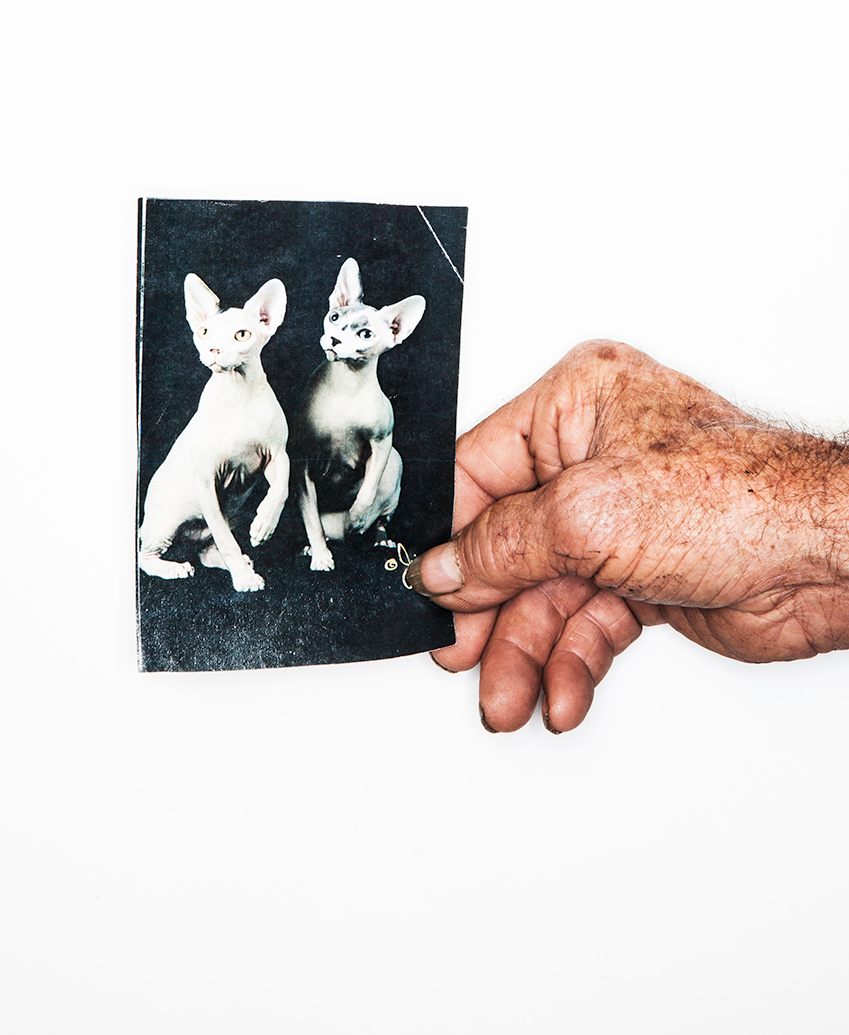
Cowboy, with Jimmy Carter.
It’s been about six weeks and 15 phone calls, but I still haven’t managed to get ahold of Jake Perry himself. So I’ve been interviewing his neighbors. One lets me peep over her backyard fence, and from there I can see Perry’s DIY pet cemetery, along with a screened-in pen he’s added so the cats can go outside and watch actual nature (when they’re not watching nature documentaries).
Diane Bennett, a former next-door neighbor of Perry who worked on the student documentary that profiled him in 2003, described the inside of Perry’s home then as a “virtual jungle gym/cat playground.” Bennett tells me that “he had built tracks along the walls so that the cats could transit the house like hamsters in tubes.” Perry’s dedication to his cats is clearly a central focus of his life. Even those who have known Perry for years know little about his wife and children, but know everything about the cats.
“He’s the nicest of guys. All he does is talk about his cats, you know, or the plumbing,” says Bill Malone, a home remodeling contractor who’s worked with Perry for the past five years. “There’s no in-between.”
And yet, the cats aren’t simply one man’s obsession; they’re something of an Austin legend. Betsy Williams, a vet tech at South Congress, remembers the calendars of Granpa passed out to local businesses, and the personalized T-shirts that were printed when the cat turned 34. Local and national news media attended some of the older cats’ birthday parties. In 2011, The Austin Chronicle included Perry in their Best of Austin issue, naming him the “Best Retired Plumber With Some Claims to Fame,” and stating that “unlike his cousin [former Texas governor Rick Perry—yes, really] … Perry is well-known and well-liked around Austin.” When Granpa finally passed away, donations from domestic and international fans flooded in, enough to purchase the headstone that marks the cat’s final resting place in Perry’s backyard.
Even postmortem, Perry’s cats have an enviable fan base, but after interviewing 10 current and former neighbors, three students who made the documentary (it’s called South Paws), a coworker, and two members of the cats’ vet care team, the man himself remains a mystery. Just when I’m convinced I’ll never find out what drives a person to take his cats to PetSmart up to seven times a week, or remodel his home to better serve his pets, Jake Perry calls back.
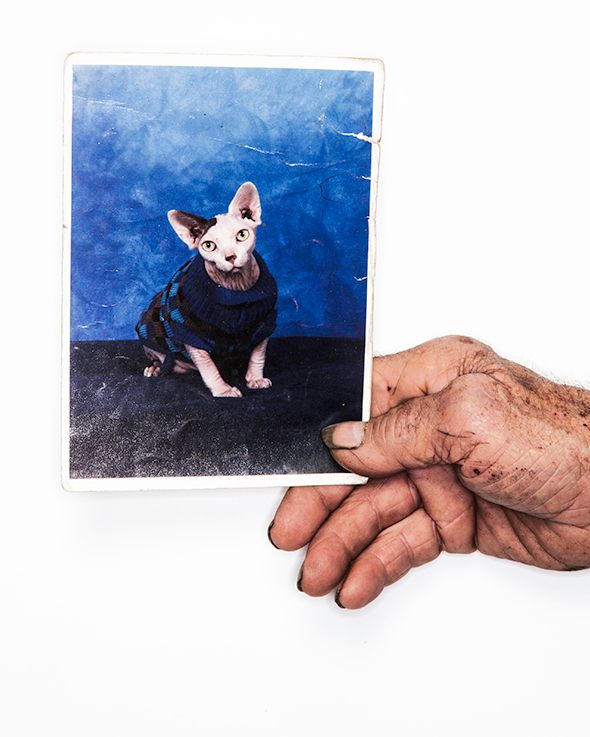
Jake’s cat Cowboy.
The Cat Man starts with a gentlemanly apology. Much has changed since the bathtub fix of 2012. A battle with pancreatic cancer (from which he has since emerged victorious) has mired him in a flurry of doctors’ appointments and medical jargon. But he’s happy to share more about his cat-rearing techniques—which turn out to be more wonderfully weird than I’d realized. In addition to nature documentaries, his homemade movie theater screens 3-D films that require cat viewers to wear plastic red-and-blue glasses. Perry’s cats always celebrated Easter with baskets and eggs filled with treats, Thanksgiving with turkey and long naps, and New Year’s Eve with tiny cat hats and Champagne—a beverage Granpa liked so much, “I had to keep a little bottle for him.” Every Christmas, Perry and Granpa headed to PetSmart so Granpa could pick out gifts for the cat clan. Back at home, Perry assembled an electric train that ran around the house, sometimes carrying feline freight-hoppers as it passed. But what motivates him to go to such lengths? Perry answers without hesitation. “I love them,” he says. “And another thing: When I go to the shelter, the old heart starts ticking. [I see them and think] I want you.”
At 85 human years, Perry is finally focusing on himself. He’s staring down his own mortality and thinking about how he wants to spend his remaining days. “I’m hoping if my condition works out, I might sell this place and move to the country,” he says. “My little dream [is] to open up a pet cemetery.”
The cats would come too, even the dead ones. The corpses of 47 of Perry’s cats are sealed in fiberglass baby caskets and buried in his backyard. Granpa’s donation-funded headstone marks the somber spot, as does a nearly 3-foot-tall Virgin Mary statue that looms over the grave. The burial is an important part of finding peace when a beloved pet passes, Perry adds, as is honoring their lives with a viewing and memorial service open to friends and family.
“I’ve still got a video somewhere from when Granpa died,” says Betsy Williams, the vet tech. “The cats would walk up [to the casket] and kind of sniff at him and walk past. It was like a human funeral service.”
But Perry is hardly ready to give up on the living. He has one cat left, and therefore, hope for one more world record. This would be Jean Claude Van Damme, also known as Cowboy. Clocking in at 19 years—a whipper-snapping 89 people years—Jean Claude is the last to indulge in the homemade breakfasts, the jungle gym, the film screenings. He’s also among the wealthiest cats in Texas. In 1998, Perry says he won around $50,000 playing Granpa’s birthday numbers on a lucky Cash Five lottery ticket. He tells me that the winnings, combined with several smaller jackpots won through the years, were invested in a trust for the cats to be used either for their care upon Perry’s passing, or Perry’s own care in the case of a medical emergency.
Bruce Hardesty is keeping an eye on both Perry and his cat. He’s watching Jean Claude Van Damme’s health and noting when Perry is due in next. “If every once in a while we don’t see him, we’re afraid something … might have happened to him,” Hardesty says, “ ’Cause I’ll tell you, the world’s going to be a lesser place when Jake Perry’s not in it.” While Perry thinks it’s his methodology—the diet, the mental stimulation, the sterilization—keeping his cats alive, Hardesty believes the formula could be as simple as plain old love.
Should Perry get his wish of opening a pet cemetery, he’ll eventually be buried there too, right beside the pets he treated as members of his more conventional family. “These are my children,” he says with that unmistakable Texas drawl. “I looked after them until they passed on. That’s the way I was raised up.”
In the meantime, “If a sick cat comes here in the yard, you know what I’m going to do?” he says. “I’m gonna take ’em to the vet.”
![]() This story was co-produced with mental_floss magazine and appeared in the Jan/Feb 2016 issue. Click here to subscribe.
This story was co-produced with mental_floss magazine and appeared in the Jan/Feb 2016 issue. Click here to subscribe.
To chat with the author of this piece, check out the Digg Dialog here.


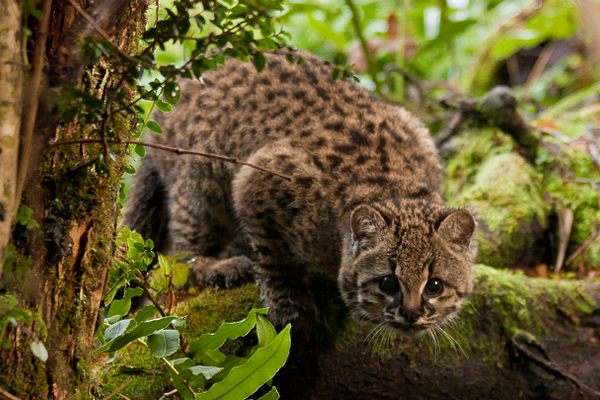
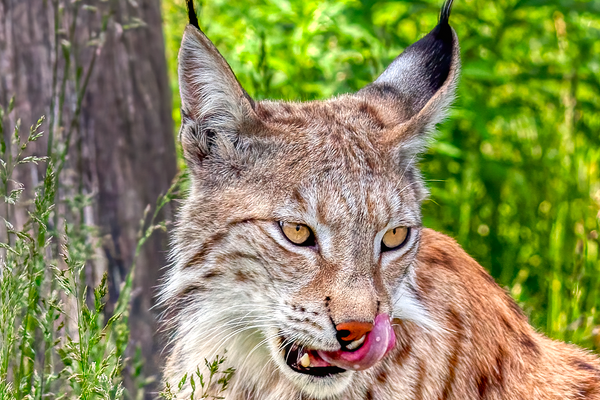


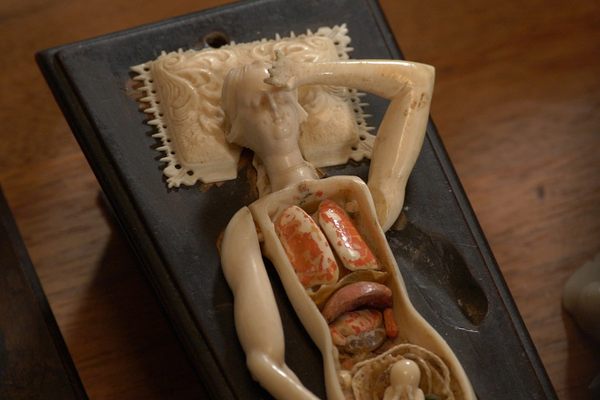



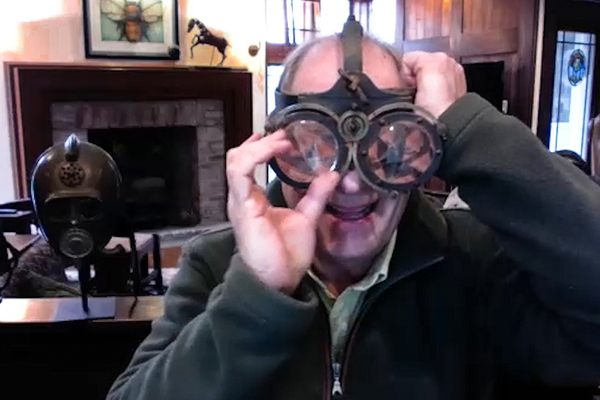










Follow us on Twitter to get the latest on the world's hidden wonders.
Like us on Facebook to get the latest on the world's hidden wonders.
Follow us on Twitter Like us on Facebook